8 Attributes that Make Your SaaS Product Hard to Copy
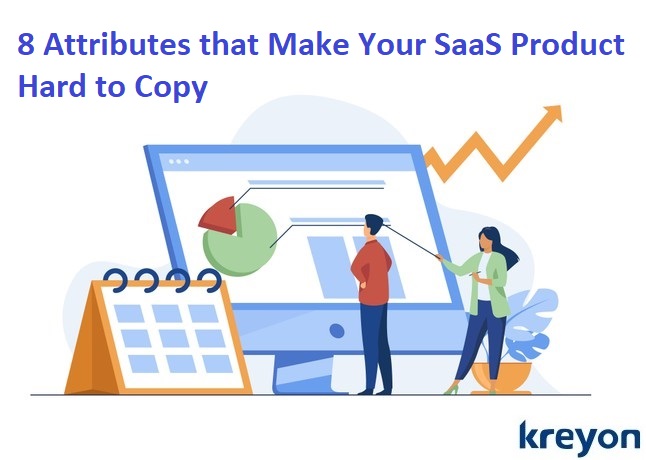
One of the key elements of positioning your SaaS product is to build things that are hard to copy. When you’re building SaaS products, all your features, research and development will be open for competitors to copy from. What makes your product unique, hard to copy and difficult to beat? This is an important strategic step towards building a sustainable and successful product. Here’s a look at attributes that make products hard to copy:
1. Product Experience
Is your product experience delightful? What are the features that delight your customers? Is your company geared towards consistent improvement in delighting your customers? For e.g. Netflix provided delightful streaming services for its users. It added gamification models to get first time consumers to review at-least 50 movies & shows in the first 3 months of usage. This helped them provide recommendations and choices based on their preferences.
It is hard to build consumer experience features that cannot be replicated easily. It works with an algorithm that has inbuilt intelligence to tap into customer preferences and choices. The product is developed to prioritise improvement of user experience and delighting customers with unique features that work behind the scenes with data.
2. Your Brand
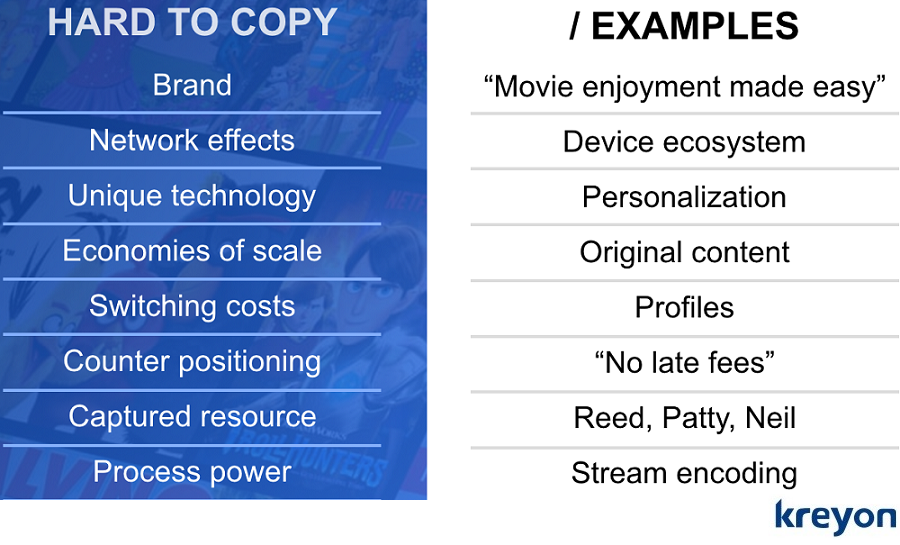
Your brand identity shapes your customer’s behavior and attracts them towards your products & services. In this age of digital tools and technologies, how your brand interacts and establishes connections with customers is more important than ever.
Great brands are using everything in their arsenal to personalise interactions with their customers. They are using technology to learn more about their customers and finding ways to serve them better. Brands that connect, deliver and enhance customer’s lives & care for them are always hard to beat.
3. Network & Distribution
A company’s network and distribution strategy can influence the adoption of its product significantly. The most successful products are built with a careful outreach strategy. How will you reach your customers? Who can help you reach more customers faster in a cost effective way? What are the new partners and models that can multiply your reach to the customers?
Companies with a strong existing network of partners and distributors can reach more customers faster. When Uber started its marketing, it targeted reaching out to tech conferences and offered free rides to the participants there. The tech savvy audiences immediately took to Uber and started spreading the word about it. The unique strategy to reach your customers is part of the product strategy that every company needs to conceive.
4. Technology Trends & Unique Capabilities
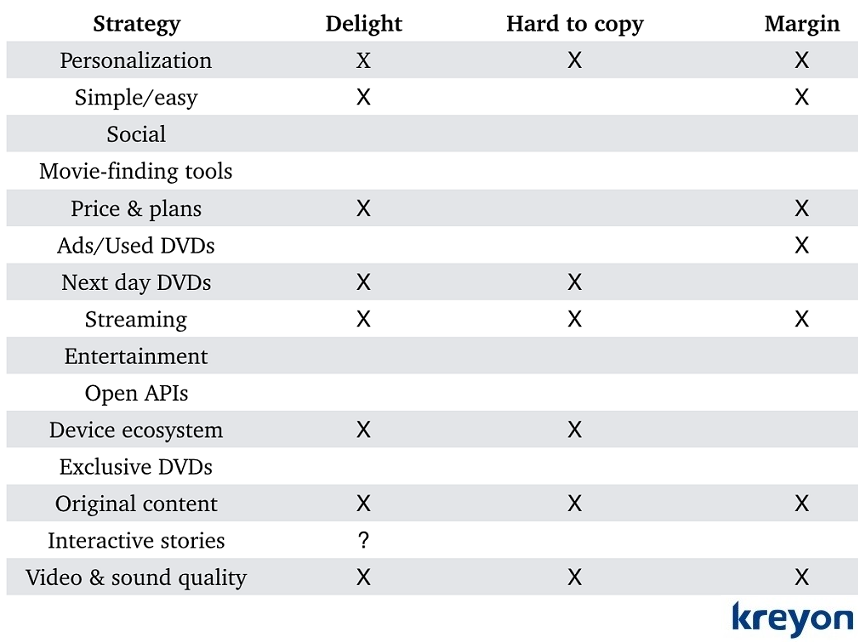
What are the technology trends you’re banking on for your products? Is your product betting on advanced technologies and unique capabilities? For e.g. Netflix developed streaming technologies & a subscription model for DVDs to reach out more customers than its competitors who were using renting out DVDs from physical stores. Facebook developed a unique friend search algorithm that allowed people to build their online networks faster than Myspace and other competitors.
Your product can leverage unique technology trends like use of AI, voice recognition and AR/VR etc. to develop value added features. Over time the efforts spent on research and development are visible with the unique set of features that are difficult to replicate.
5. End to End Capabilities
Products that dominate their space provide the complete ecosystem for their customers to accomplish their needs. When Salesforce introduced its SaaS based CRM product, it leapfrogged ahead of its competitors. However, Salesforce has been able to innovate and provide a complete ecosystem. It provides useful tools and technologies for teams to build value added apps, it has a complete set of business apps, consultants and technologies to take care of customer’s evolving needs.
When Apple launched the iPod, they not only provided a device which was superior compared to its existing competitors, but also provided a way to buy songs from iTunes. Products that provide a complete ecosystem and take care of customer’s needs are hard to build and copy. Netflix started with a subscription based service for DVDs, but soon started its video streaming, personalisation, anytime anywhere device ecosystem, & original content for its users.
6. One Thing
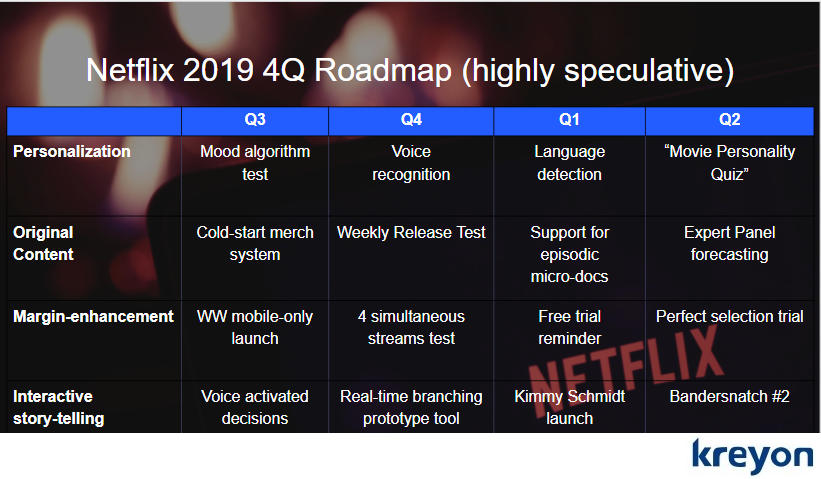 Products that beat their competitors do one thing better than others. Take for e.g. when you think of Apple, you think of design. Google is the search engine of the world’s information. Dropbox is the goto solution for storage.
Products that beat their competitors do one thing better than others. Take for e.g. when you think of Apple, you think of design. Google is the search engine of the world’s information. Dropbox is the goto solution for storage.
When your product is focused on providing one essential thing your customers want, it can build a great advantage. Focusing on one thing and doing it well takes great efforts. But it pays off very well. Companies that build products that are hard to develop and copy can leap ahead of their competitors. The market rewards excellence and when products display authority, consistency and value, they’re hard to copy.
7. Growth Engagement & Monetization
Your product strategy shapes and guides your product’s growth, engagement and monetisation. The best products are shaped with a strong roadmap and focus on innovation, growth, customer engagement, margin enhancing features, customer help and support etc.
The product strategy helps your company adopt the right set of features to focus on growth. It helps you create metrics to measure growth.
How do you measure growth for your business?
How do you measure engagement of users with your product? Are customers using your product features?
How is your product going to deliver value for your business?
How do you measure the financial metrics for your product like revenue per customer, lifetime value of customers, & net profit etc.
A strong GEM model will help your business build a better product. It helps you focus on the right metrics to deliver lasting value to the customers as well as your business. SaaS product companies often measure the YOY revenue, retention rate, lifetime value, gross profit & time spent on products etc. to improve their business.
8. Bottom Up Approach
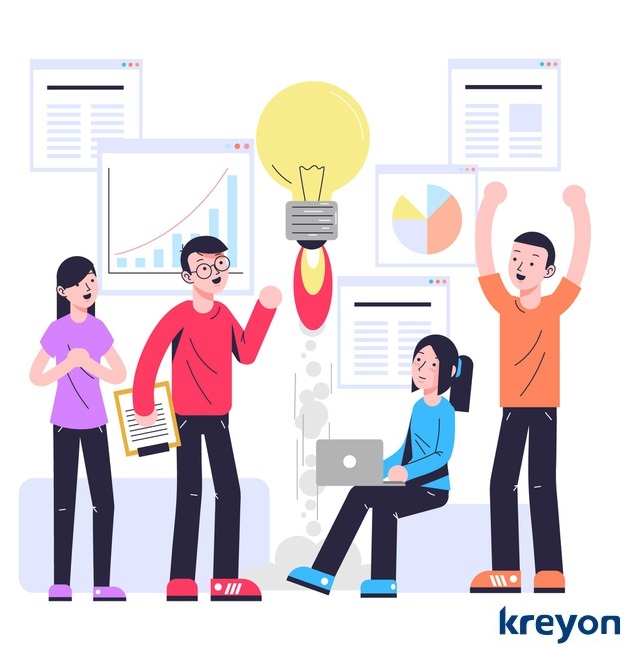
Your customers are the reason for your product’s success. When they are satisfied and happy, you have a successful business. A lot of products are built in a silo without real customer interactions and feedback. But the successful products are built inline with what the customer needs are.
When product features are conceptualised in a bottom up approach, it develops a more robots product. Take for e.g. brands like Youtube & facebook etc. use proxy metrics to measure customer interactions with their products. Youtube measures things like the average time spent per user daily watching videos, Facebook tracks the number of daily active users and features on which they spend maximum time.
The SaaS product development is shaped by customer usage patterns and inputs. When brands are directly connected to their customers and figure out ways to address their needs, it gives them a unique advantage that is hard to replicate.
Kreyon Systems is a leading SaaS product development company. If you have any queries for us or need help in implementation of SaaS products, please reach out to us.
